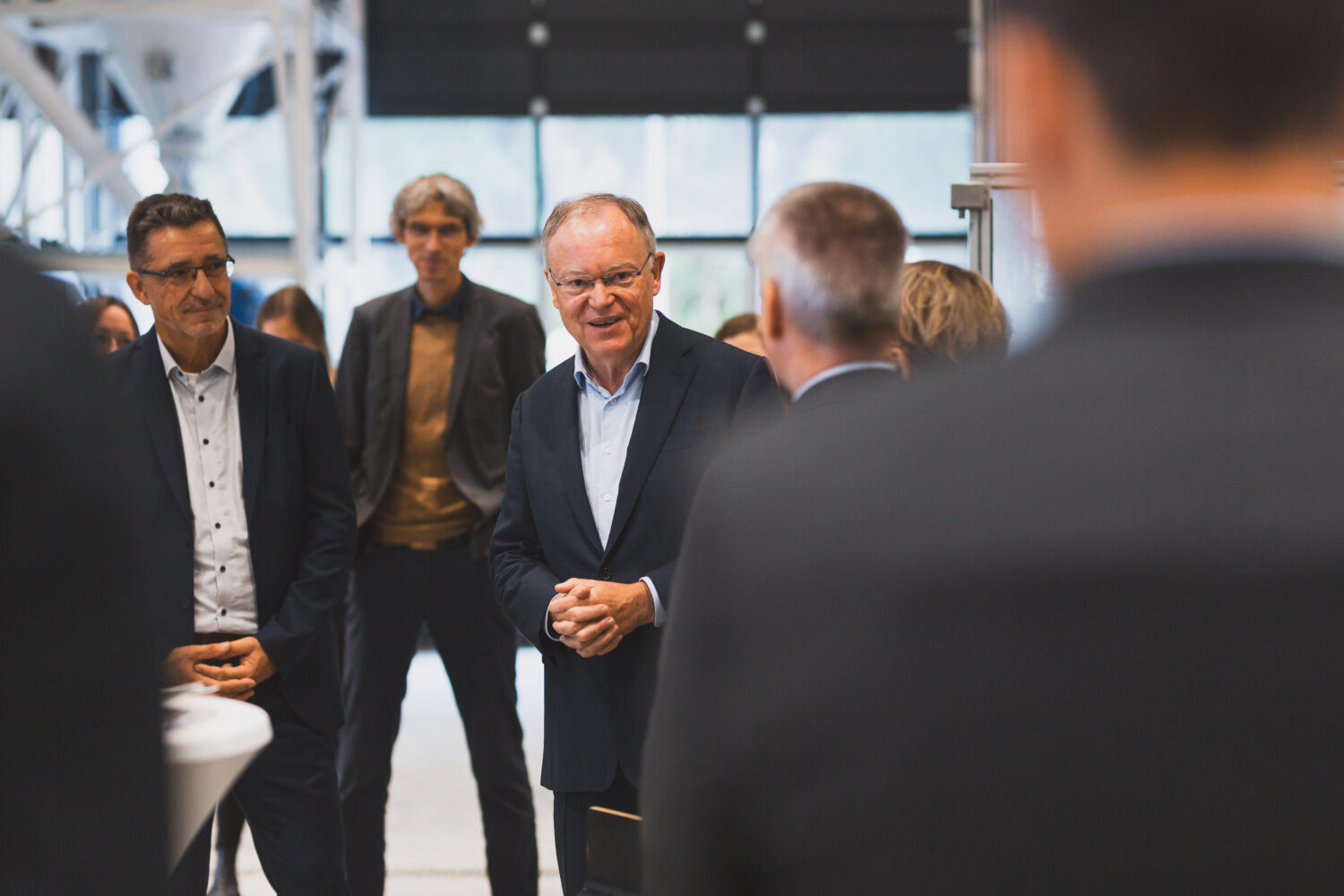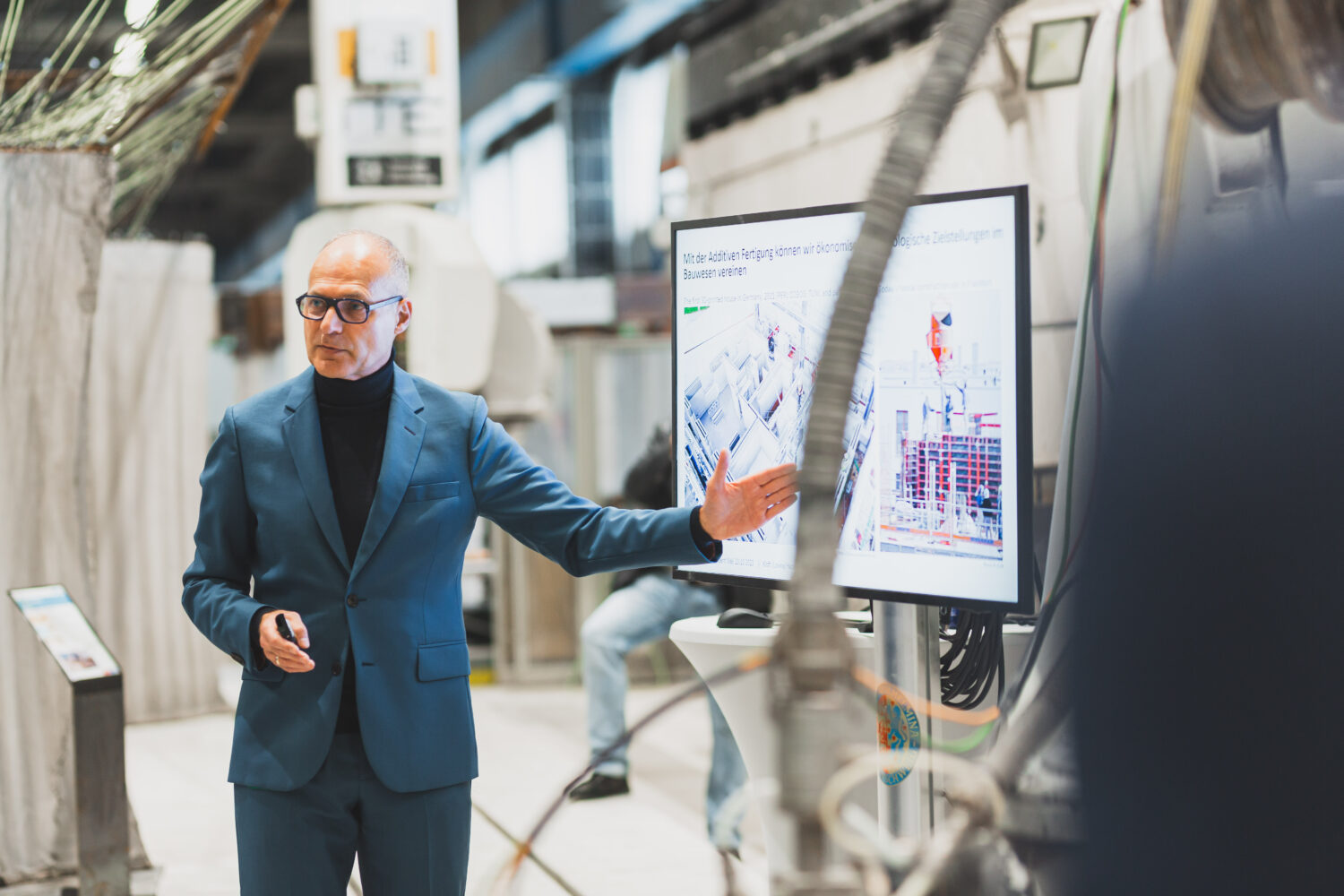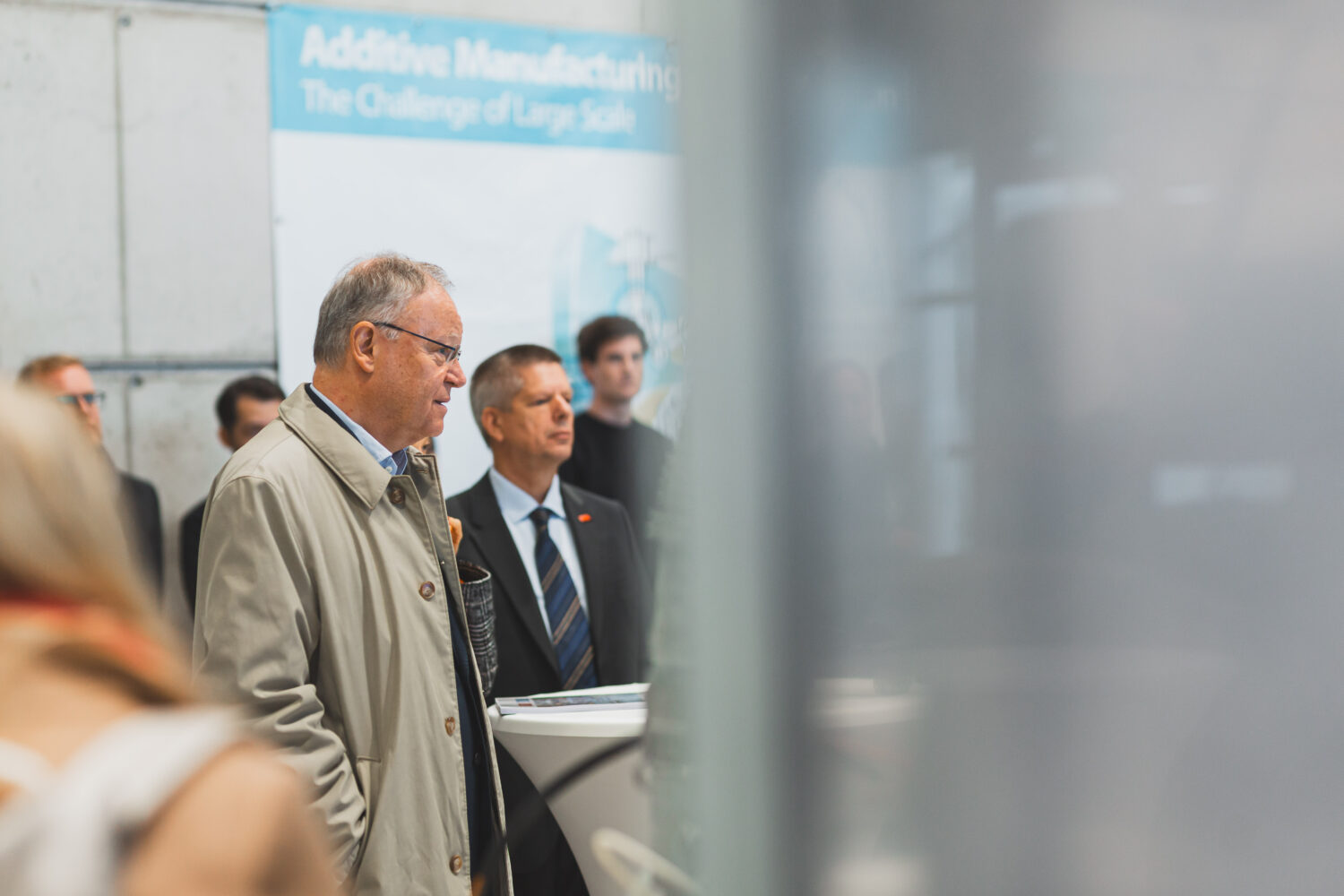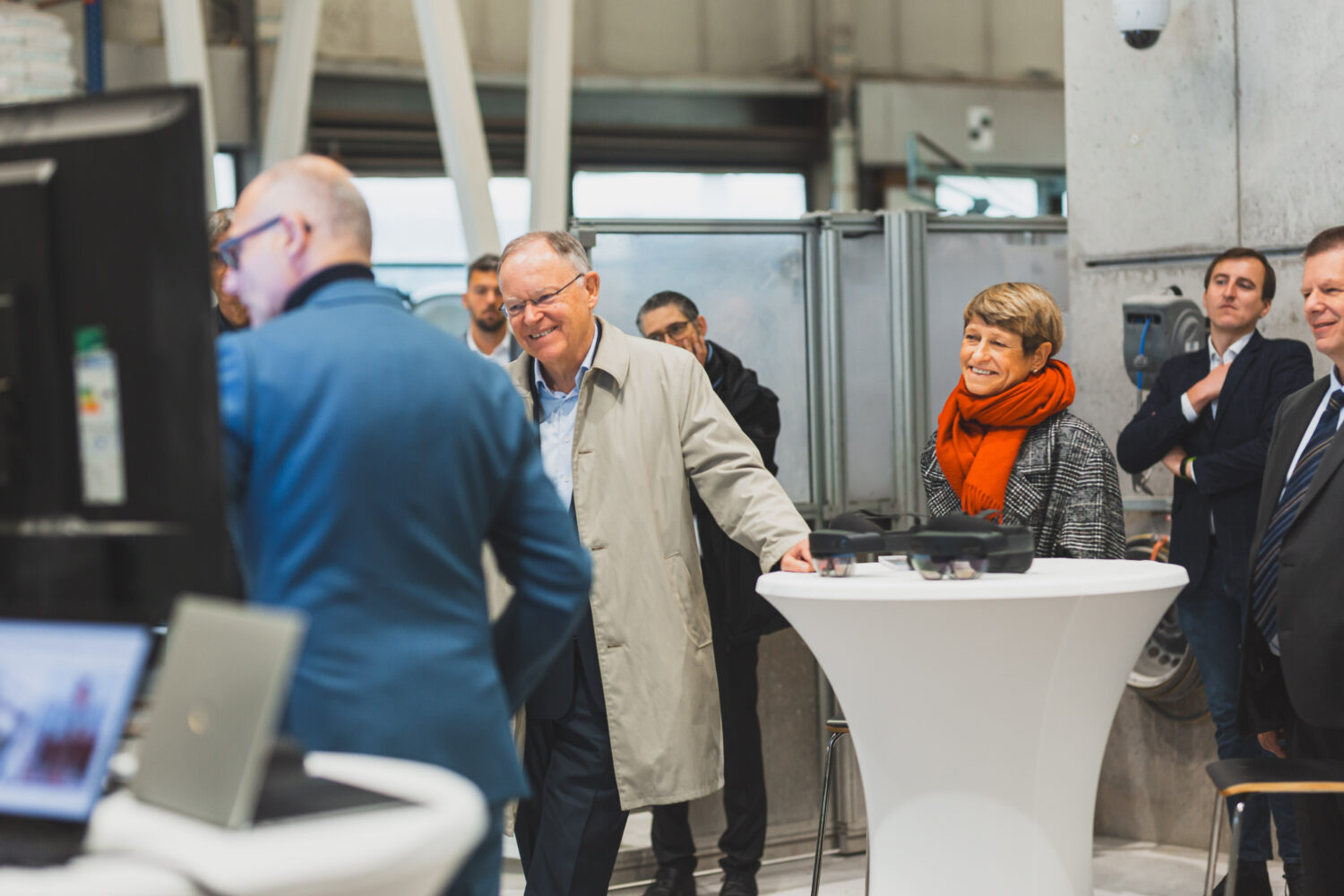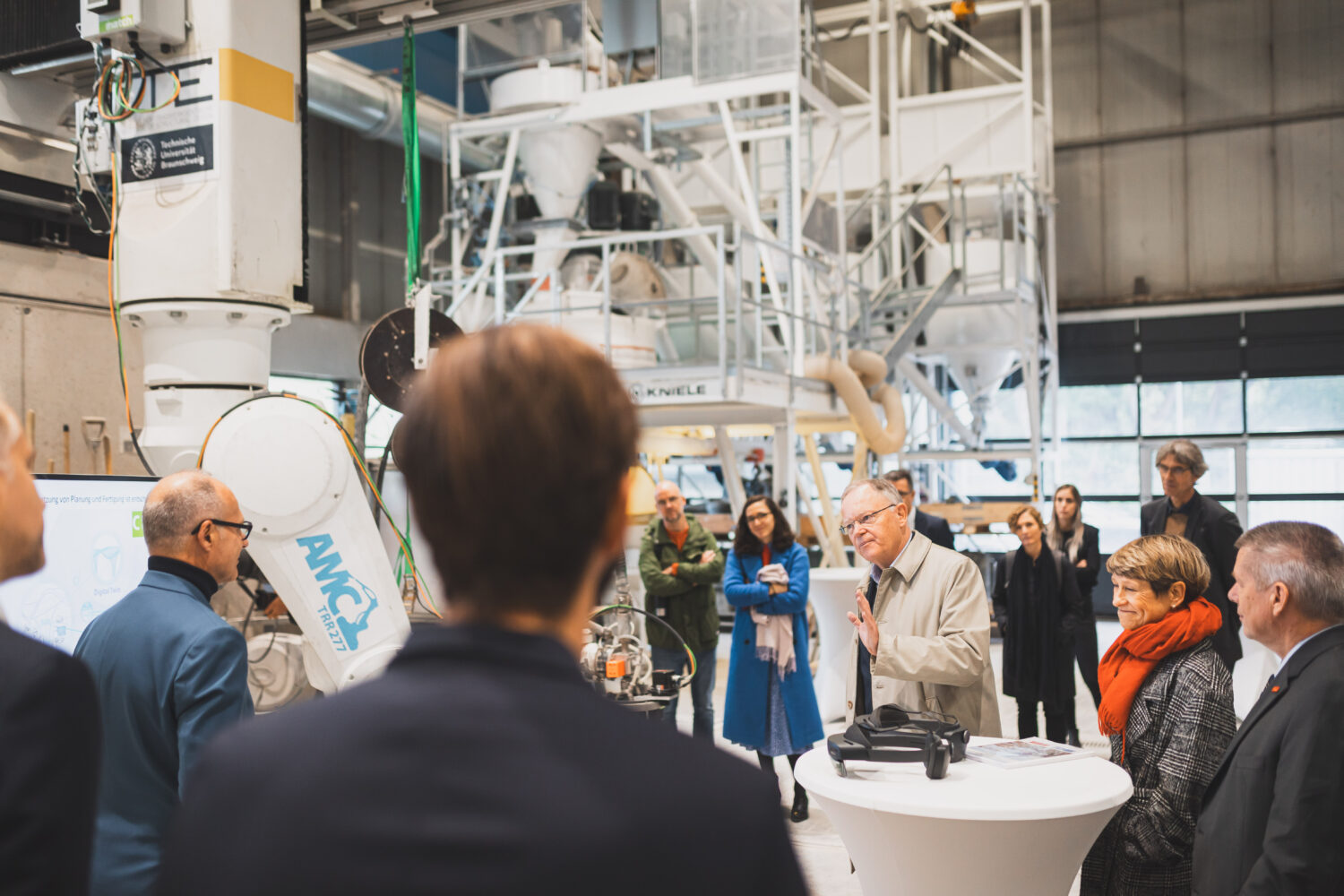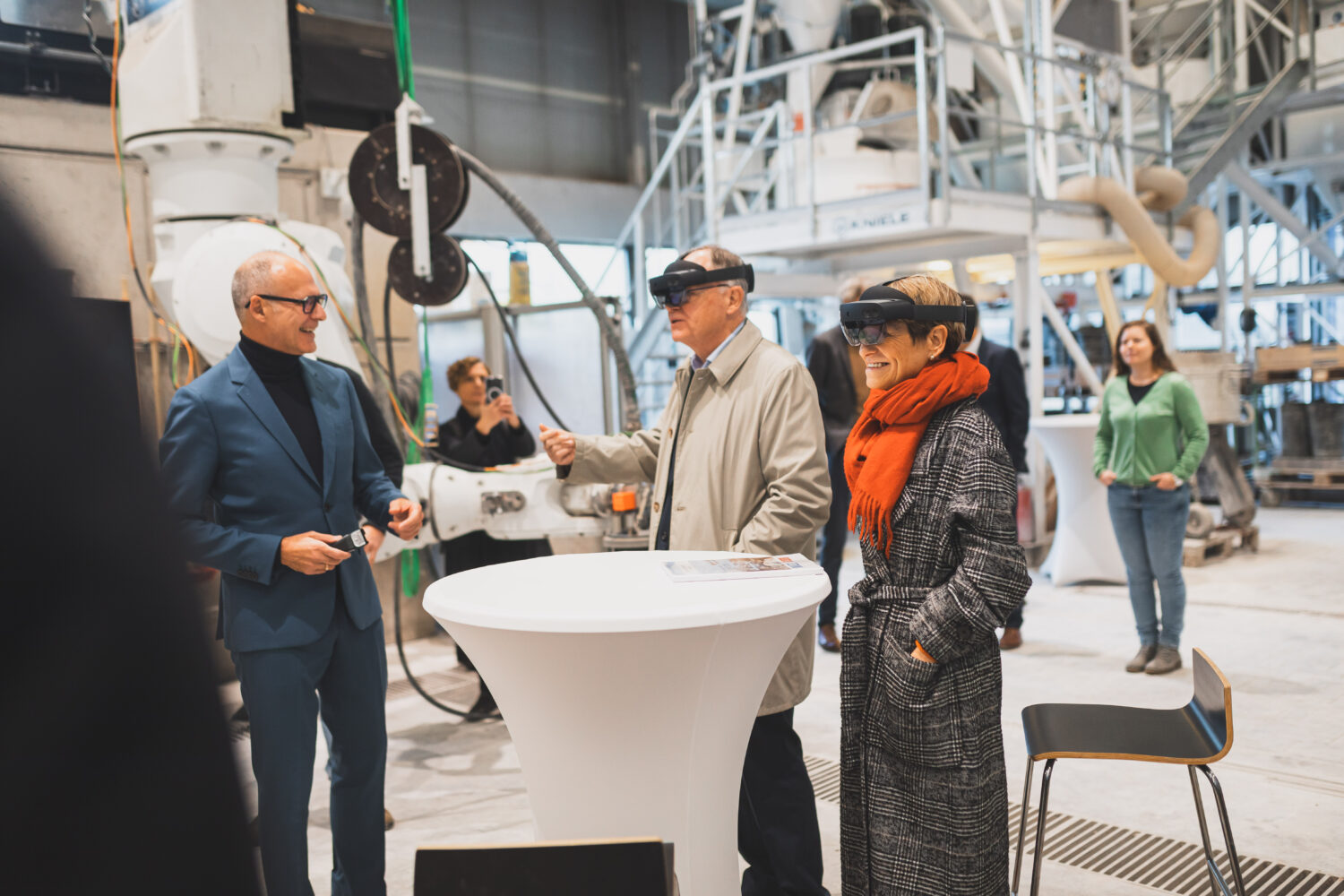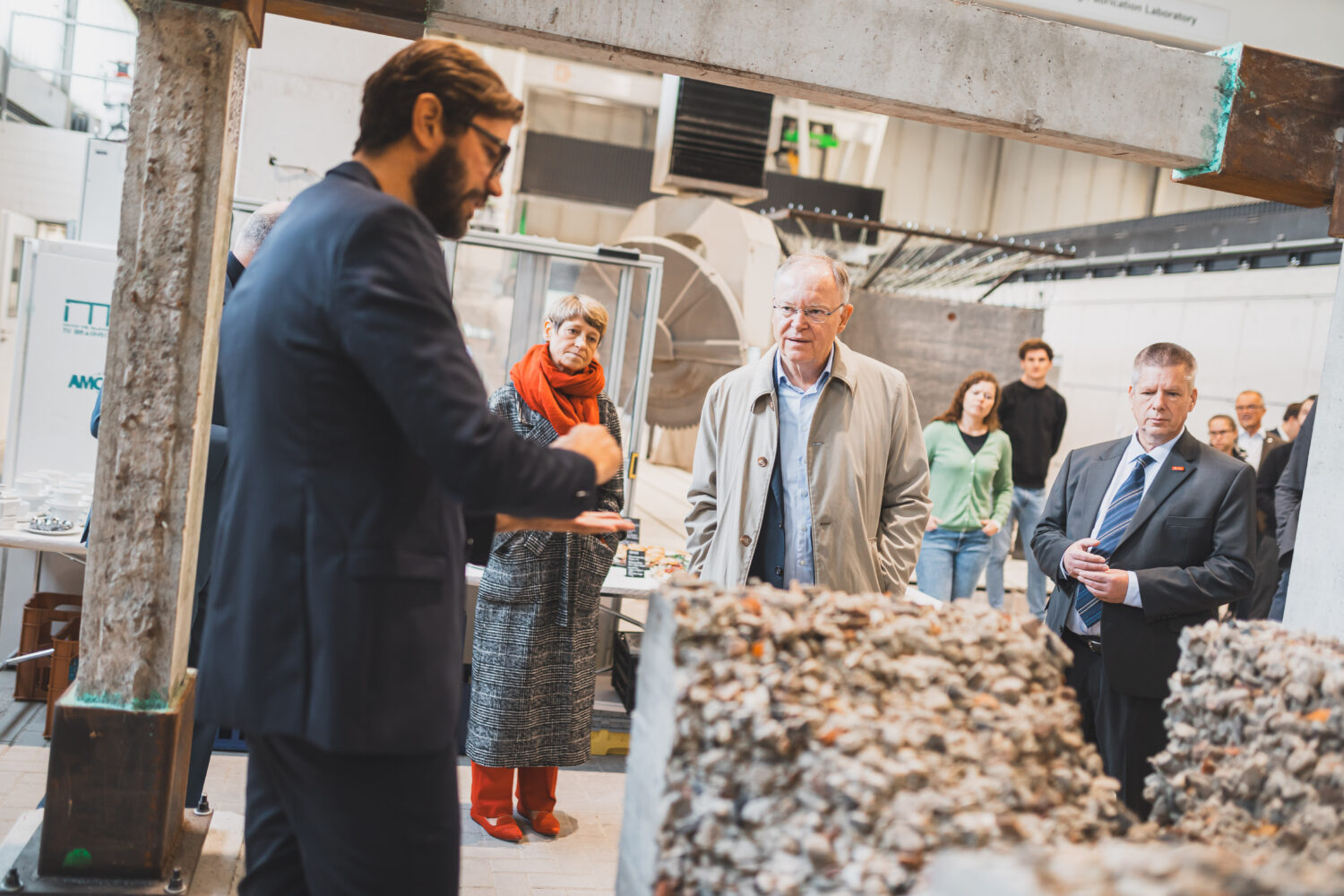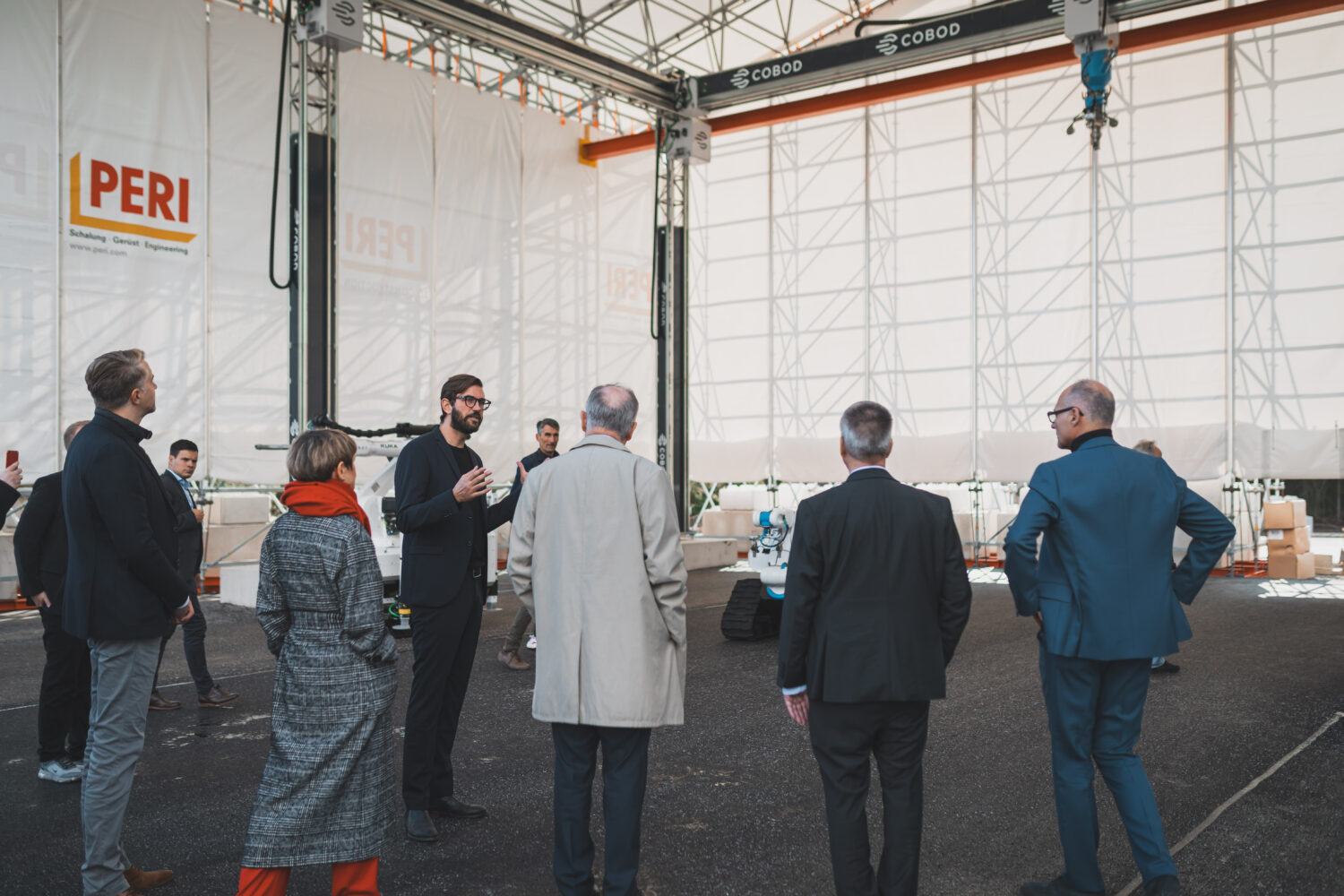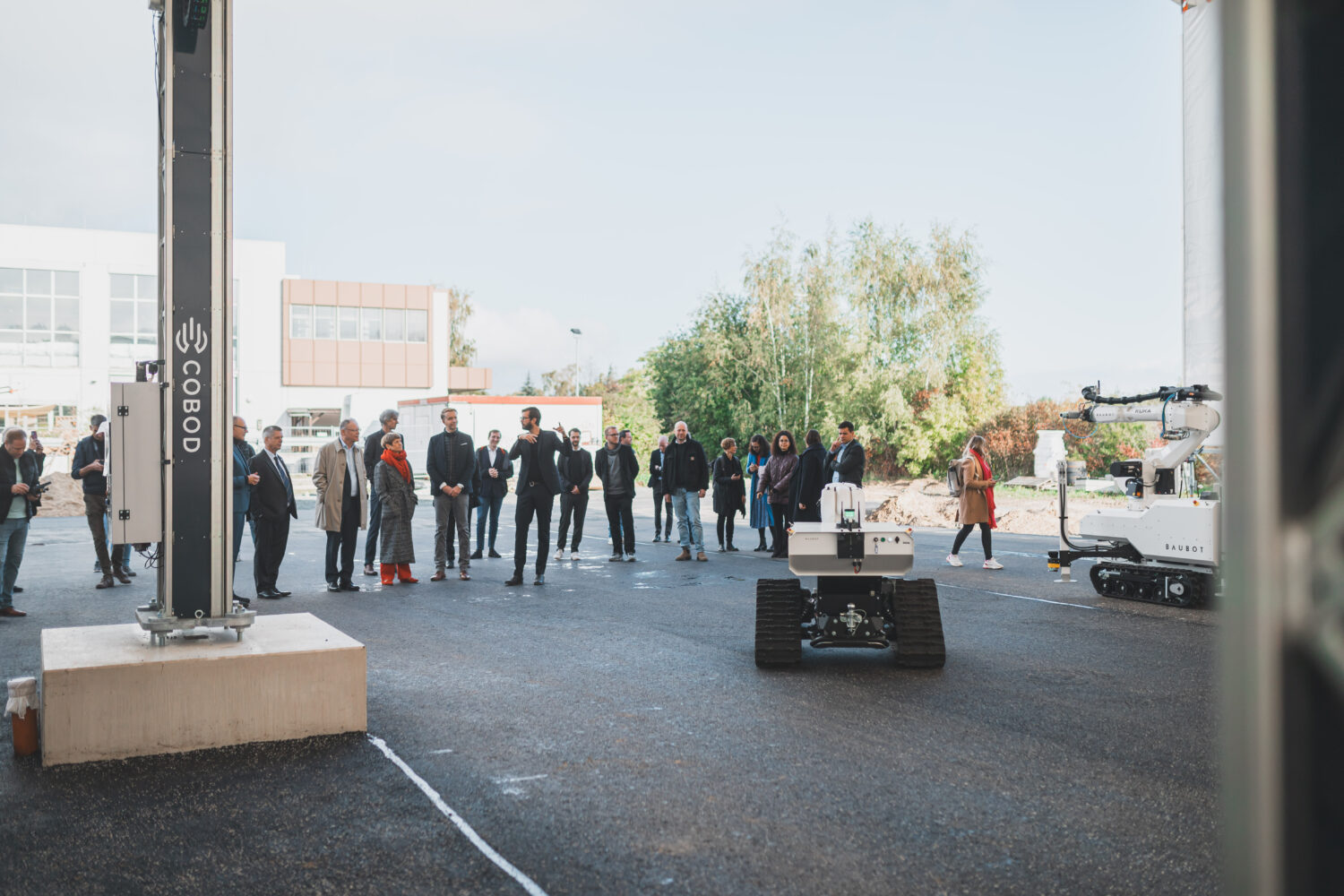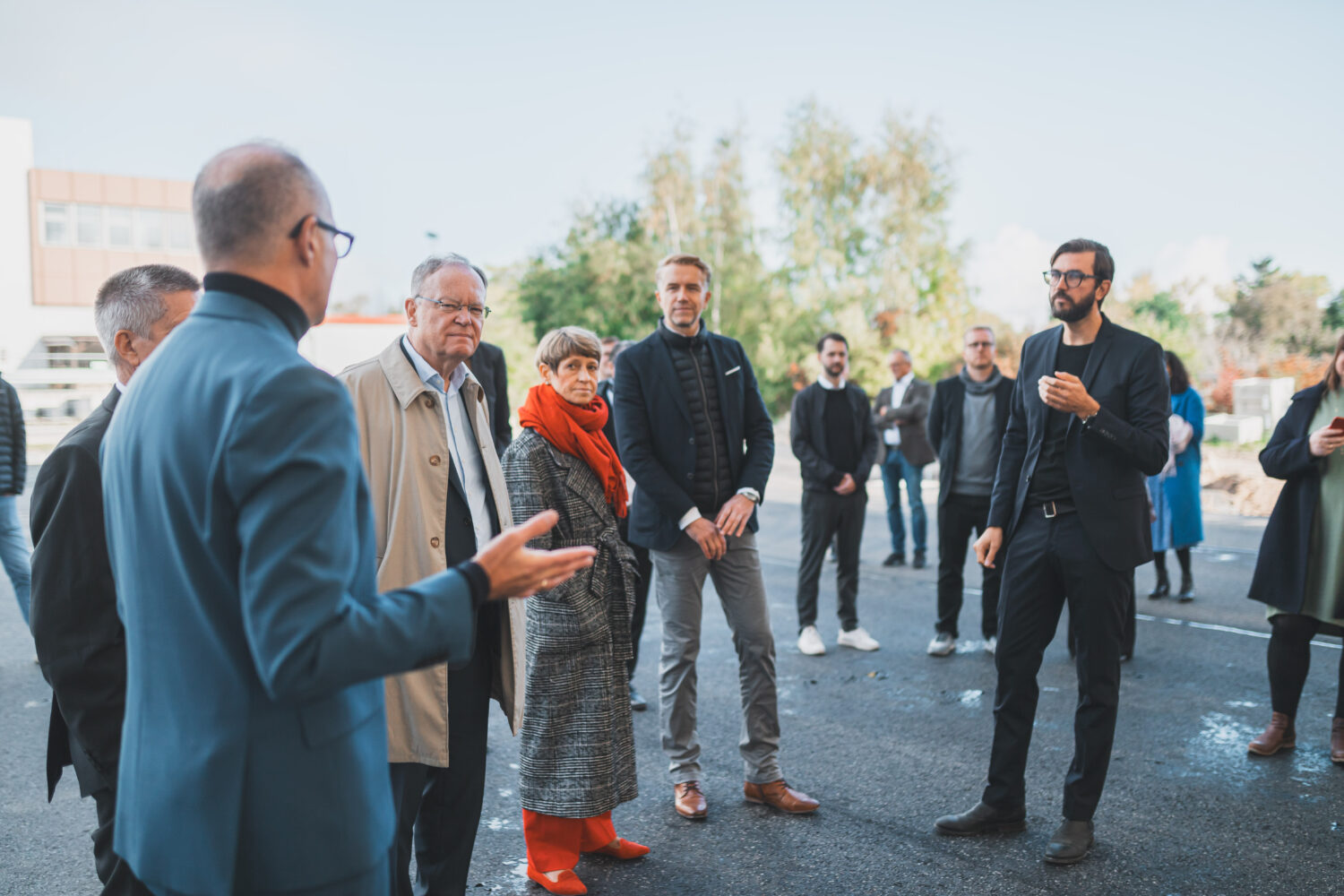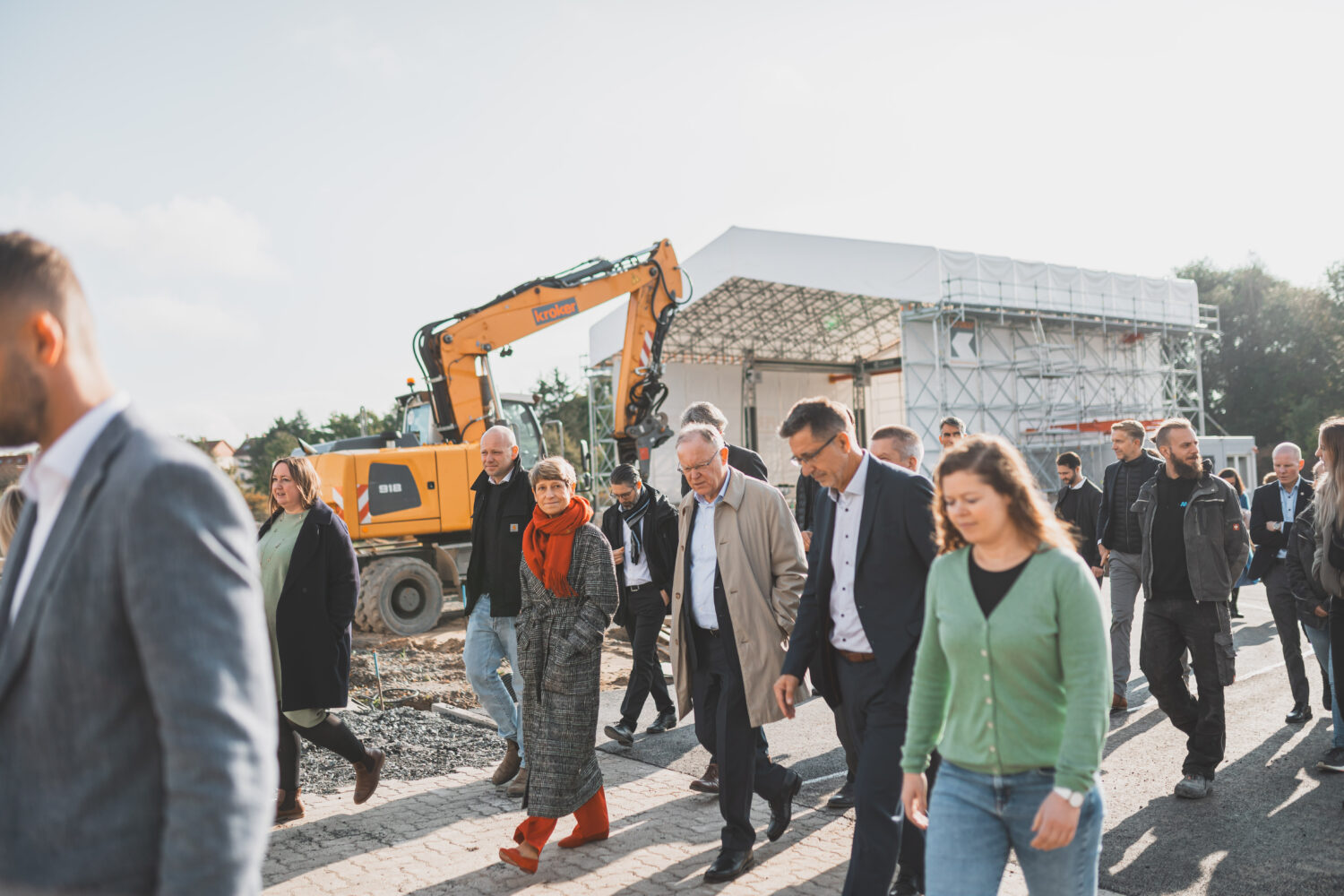Build with the 3D printer: Stephan Weil visits TU Braunschweig
Buildings are part of our cultural development. New technologies are now needed to make construction more environmentally friendly, faster and more economical. Scientists at the AMC Collaborative Research Centre see additive manufacturing, or 3D printing, as a key digital technology for the construction of the future. On 23 October, the scientists showed Lower Saxony’s Minister President Stephan Weil how they are conducting fundamental research into 3D printing together.
“Research from Lower Saxony is a real driver of innovation, as I was once again able to see for myself today at the TU Braunschweig. New technologies are being developed here that make construction more environmentally friendly, faster and more economical – a real milestone,” says Stephan Weil, Minister President of Lower Saxony. [this quote has been translated from German and shortened; you can find the original at the following link]
Research centre for digital building fabrication
The quadrupling of the world’s population over the past 100 years has made the construction industry a global driver of resource consumption and environmental pollution.
At the same time, the construction industry is suffering from stagnating productivity and construction is barely affordable for customers. While other industrial sectors such as car manufacturing have continuously integrated technological developments into their production over the decades, construction sites are still predominantly characterised by labour-intensive manual techniques.
This is where the scientists at the Additive Manufacturing in Construction (AMC) collaborative research centre come in. In contrast to manual construction techniques, 3D printing involves building up a component layer by layer and giving it its three-dimensional form: mould construction, industrial pre-processes or complex adaptation processes for semi-finished products such as blanks are not required. “At the dawn of the digital age, we have a great opportunity to use 3D printing to pave the way for a paradigm shift in the construction industry, namely to focus on the value of the material and not on labour costs due to outdated construction techniques. Additive manufacturing has the potential to become a key digital construction technology to make building more productive, environmentally friendly and affordable,” says Professor Harald Kloft, Head of the Institute of Structural Design (ITE) and spokesperson for the Collaborative Research Centre.
TU Braunschweig has already been researching 3D printing processes for the construction industry for ten years and has thus established itself as a research centre for digital construction fabrication.
Digital construction fabrication centre: “Rethinking buildings from scratch”
But what does this look like in practice? Minister President Stephan Weil was given an insight into this in the Digital Building Fabrication Laboratory (DBFL). The large-scale research facility, which is 16 metres long and nine metres wide, is a digital building fabrication centre. It includes a CNC milling machine, a six-axis robotic arm and an automated concrete mixing plant. Here, components – such as walls, columns, ceilings and bridges – are printed on a 1:1 scale and the interactions between material, process and moulding are researched: “3D printing enables us to rethink buildings from scratch. More resource-efficient, lower-emission, efficient and with new creative freedom for architecture,” says Norman Hack, Professor of Digital Construction at ITE.
Concrete, steel, clay
Using the DBFL, the scientists not only print concrete, but also steel and clay, build up the material in layers, inject it with a robotic arm, as in the shotcrete 3D printing process, or inject strands of material into a carrier medium to create filigree structures. “The interaction of material and 3D printing processes is of fundamental importance for the quality of the printed components,” says Dirk Lowke, Professor at the Centre for Building Materials and Materials Testing at TU Munich. The scientists also showed how concrete components from existing buildings to be demolished can be reused. Here, real-digital process chains help to extract concrete components from existing buildings and reuse them as “secondary components”. Research is also being conducted into the use of precision formwork made from 100 per cent recyclable industrial waxes. The wax can be melted down again and offers completely new forms of formwork.
“The achievements of the DFG Collaborative Research Centre TRR 277 ‘Additive Manufacturing in Construction’ are forward-looking for the construction industry and society. The work of this highly efficient research area will fundamentally revolutionise the construction industry,” summarises the President of TU Braunschweig, Angela Ittel. “The research group is also an outstanding example of how successful and enriching cross-university and interdisciplinary collaboration can be. We are also planning to expand this collaboration in the future. Together with the Technical University of Munich, for example, we have launched an outline for a joint Cluster of Excellence to investigate further research into new construction technologies and their integration into the economy and society.” [quote has been translated from german]
Braunschweig, 24th October 2023
About TRR 277 AMC:
The Collaborative Research Center TRR 277 Additive Manufacturing in Construction (AMC) is dedicated to advancing research in the field of construction, with a focus on leveraging 3D printing technology to revolutionize sustainable and energy-efficient building practices. Through innovation and collaboration, the center aims to usher in a new era for the construction industry. In the interdisciplinary, cross-location and dfg-funded research project, the two universities TU Braunschweig and TU Munich, pursue the novel manufacturing approach for the construction industry. Additive manufacturing can develop into a key technology for the digitalization of the construction industry. Complex research questions on materials, process engineering, control, modeling, design and construction are being investigated holistically by scientists from the fields of civil and mechanical engineering.
About Digital Construction Site:
The project “The digital construction site – construction industry 4.0 as the key to a digital and sustainable construction industry” was initiated by five professors. In addition to the Institute of Construction Economics and Construction Management (Prof Patrick Schwerdtner), the Institute of Structural Design (Prof Harald Kloft, Prof Norman Hack), the Institute of Building Materials, Concrete Construction and Fire Protection (Prof Dirk Lowke) and the Institute of Geodesy and Photogrammetry (Prof Markus Gerke) are also involved in the project.
Contact:
Meike Bährens M.A.
PR & Communication Coordinator
Tel.: +49 531 391-3579 | Mobil: +49 171 389 5358
E-Mail: m.baehrens@tu-braunschweig.de | www.amc-trr277.de
https://www.linkedin.com/company/amc-trr277/
https://www.instagram.com/additivemanufacturing_trr277/
german version:
Bauen mit dem 3D-Drucker: Stephan Weil besucht TU Braunschweig
Ministerpräsident informiert sich über digitale Baufabrikation
Bauwerke sind Bestandteil unserer kulturellen Entwicklung. Neue Technologien sind jetzt notwendig, um das Bauen umweltfreundlicher, schneller und wirtschaftlicher zu machen. Wissenschaftler*innen der Technischen Universität Braunschweig sehen in der Additiven Fertigung, dem sogenannten 3D-Drucken, eine digitale Schlüsseltechnologie für das Bauen der Zukunft. Wie sie das 3D-Drucken gemeinsam mit der TU München im Sonderforschungsbereich „Additive Manufacturing in Construction“ grundlegend erforschen, zeigten die Wissenschaftler*innen Niedersachsens Ministerpräsidenten Stephan Weil am 23. Oktober.
„Forschung aus Niedersachsen ist ein echter Innovationstreiber, davon konnte ich mich heute einmal mehr an der TU Braunschweig überzeugen. Hier werden neue Technologien entwickelt, die das Bauen umweltfreundlicher, schneller und wirtschaftlicher machen – ein echter Meilenstein. Und die Forschungen zu Halbleitertechnologien versprechen Fortschritte in Sachen Energieeffizienz und Leistungsstärke“, sagt Stephan Weil, Ministerpräsident des Landes Niedersachsen.
Forschungsstandort für die Digitale Baufabrikation
Durch die Vervierfachung der Weltbevölkerung in den vergangenen 100 Jahren ist das Bauwesen zu einem globalen Treiber für Ressourcenverbrauch und Umweltbelastung geworden. Daneben leidet die Bauindustrie unter stagnierender Produktivität und für Kund*innen ist das Bauen kaum bezahlbar. Während andere Industriebereiche wie der Automobilbau über die Jahrzehnte kontinuierlich technologische Entwicklungen in ihre Fertigung integriert haben, bestimmen auf den Baustellen noch überwiegend lohnintensive handwerkliche Techniken die Herstellung von Bauwerken.
Hier setzen die Wissenschaftler*innen des Sonderforschungsbereichs „Additive Manufacturing in Construction“ (AMC) an. Im Unterschied zu den handwerklichen Bautechniken wird beim 3D-Drucken ein Bauteil Schicht für Schicht aufgebaut und in seine dreidimensionale Form gebracht: Formenbau, industrielle Vorprozesse oder aufwendige Anpassungsprozesse von Halbzeugen, wie Rohlingen sind nicht erforderlich. „Zu Beginn des digitalen Zeitalters haben wir die große Chance, mit dem 3D-Drucken den Weg für einen Paradigmenwechsel im Bauwesen zu bereiten, nämlich den Wert des Materials in den Vordergrund zu stellen und nicht die Lohnkosten aufgrund veralteter Bautechniken. Die Additive Fertigung hat das Potenzial für eine digitale Bauschlüsseltechnologie, um Bauen produktiver, umweltschonender und bezahlbarer zu machen“, sagt Professor Harald Kloft, Leiter des Instituts für Tragwerksentwurf (ITE) und Sprecher des Sonderforschungsbereichs. Bereits seit zehn Jahren erforscht die TU Braunschweig 3D-Druckverfahren für das Bauwesen und hat sich damit als Forschungsstandort für die Digitale Baufabrikation etabliert.
Digitales Baufrabrikationszentrum: „Bauwerke ganz neu denken“
Doch wie sieht das konkret aus? Einen Einblick erhielt Ministerpräsident Stephan Weil im Digital Building Fabrication Laboratory (DBFL). Das Forschungsgroßgerät mit einer Länge von 16 Metern und neun Metern Breite ist ein digitales Baufabrikationszentrum. Dazu gehören eine CNC-Fräse, ein Sechsachs-Roboterarm und eine automatisierte Betonmischanlage. Hier werden Bauteile – wie Wände, Stützen, Decken und auch Brücken – im Maßstab 1:1 gedruckt und die Wechselwirkungen von Material, Prozess und Formgebung erforscht: „Der 3D-Druck ermöglicht es uns, Bauwerke ganz neu zu denken. Ressourcenschonender, emissionsärmer, effizient und mit neuen gestalterischen Freiräumen für die Architektur“, sagt Norman Hack, Professor für Digitale Konstruktion am ITE.
Beton, Stahl, Lehm
Mit dem DBFL drucken die Wissenschaftler*innen nicht nur Beton, sondern auch Stahl und Lehm, bauen das Material in Schichten auf, spritzen es mit einem Roboterarm, wie beim Shotcrete-3D-Printing-Verfahren oder injizieren Materialstränge in ein Trägermedium, so dass filigrane Strukturen entstehen. „Die Interaktion von Material und 3D-Druckprozessen ist von elementarer Bedeutung für die Qualität der gedruckten Bauteile“, sagt Dirk Lowke, Professor am Centrum Baustoffe und Materialprüfung der TU München. Weiterhin zeigten die Wissenschaftler*innen, wie Betonbauteile aus abzureißenden Bestandsgebäuden wiederverwendet werden können. Hierbei helfen real-digitale Prozessketten, Betonbauteile aus dem Gebäudebestand zu gewinnen und als „Zweitbauteile“ weiter zu nutzen. Ebenso wird an der Verwendung von Präzisionsschalung aus 100 Prozent recycelbaren Industriewachsen geforscht. Das Wachs kann wieder eingeschmolzen werden und bietet vollkommen neue Formen der Verschalung an.
„Die Errungenschaften des DFG-Sonderforschungsbereichs TRR 277 ‚Additive Fertigung im Bauwesen‘ sind zukunftsweisend für die Bauwirtschaft und Gesellschaft. Die Arbeit des sehr leistungsstarken Forschungsbereichs wird die Baubranche grundlegend revolutionieren“, fasst die Präsidentin der TU Braunschweig, Angela Ittel, zusammen. „Die Forschungsgruppe ist zudem ein herausragendes Beispiel dafür, wie erfolgreich und bereichernd universitätsübergreifende und interdisziplinäre Zusammenarbeit sein kann. Auch in Zukunft planen wir, diese Zusammenarbeit auszubauen. So haben wir zusammen mit der TU München eine Skizze für ein gemeinsames Exzellenzcluster auf den Weg gebracht, das die weitergehende Erforschung neuer Bautechnologien und die Integration dieser in Wirtschaft und Gesellschaft untersuchen soll.“
Braunschweig, 24th October 2023
Über TRR 277 AMC:
Der Sonderforschungsbereich Transregio TRR 277 Additive Manufacturing in Construction (AMC) hat zum Ziel, die Additive Fertigung (den 3D-Druck) als neuartige digitale Fertigungstechnologie für das Bauwesen grundlegend zu erforschen. In dem interdisziplinären, standortübergreifenden Forschungsvorhaben verfolgen die beiden Universitäten TU Braunschweig und TU München, den für das Bauwesen neuartigen Fertigungsansatz. Die Additive Fertigung kann sich zu einer Schlüsseltechnologie für die Digitalisierung der Bauwirtschaft entwickeln. Komplexe Forschungsfragen zu Werkstoff, Verfahrenstechnik, Steuerung, Modellierung, Design und Konstruktion werden von Wissenschaftlerinnen und Wissenschaftlern aus den Bereichen des Bauwesens und des Maschinenbaus ganzheitlich erforscht.
Das Projekt „Die Digitale Baustelle – Bauindustrie 4.0 als Schlüssel für eine digitale und nachhaltige Bauwirtschaft“ wurde durch fünf Professoren initiiert. Neben dem Institut für Bauwirtschaft und Baubetrieb (Prof. Patrick Schwerdtner) sind das Institut für Tragwerksentwurf (Prof. Harald Kloft, Prof. Norman Hack), das Institut für Baustoffe, Massivbau und Brandschutz (Prof. Dirk Lowke) und das Institut für Geodäsie und Photogrammetrie (Prof. Markus Gerke) an dem Projekt beteiligt.
Kontakt:
Meike Bährens M.A.
PR & Communication Coordinator
Tel.: +49 531 391-3579 | Mobil: +49 171 389 5358
E-Mail: m.baehrens@tu-braunschweig.de | www.amc-trr277.de
https://www.linkedin.com/company/amc-trr277/
https://www.instagram.com/additivemanufacturing_trr277/

